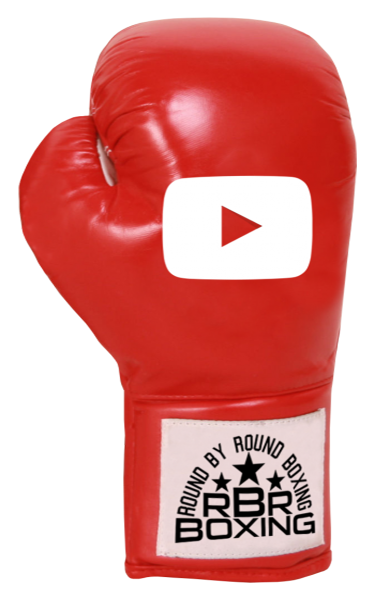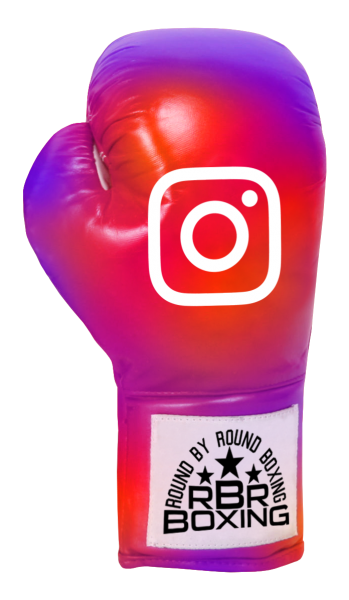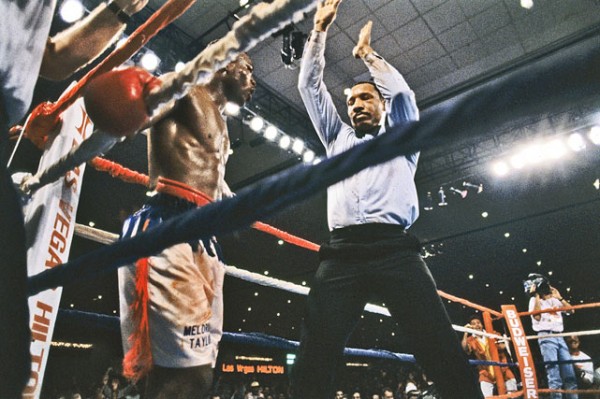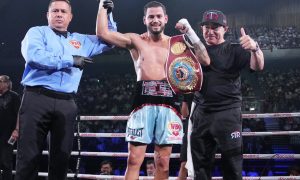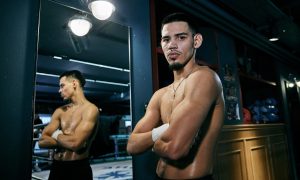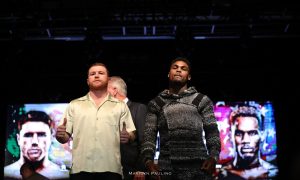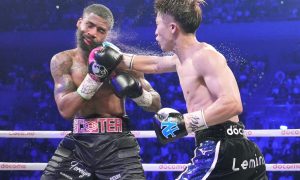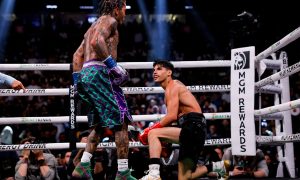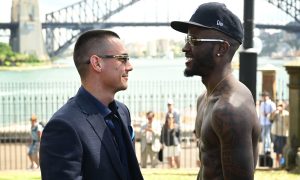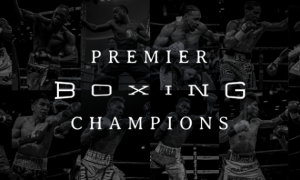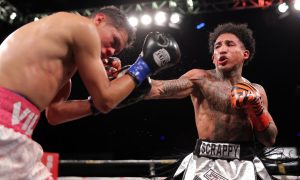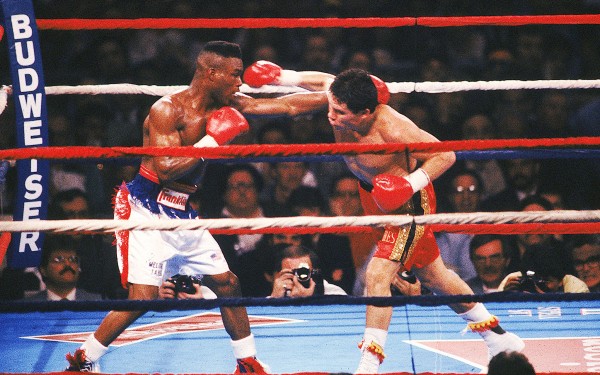 Photo by Ken Levine/All Sport/Getty Images
Photo by Ken Levine/All Sport/Getty Images
Although the year was still young, there were already a variety of newsworthy events as a new decade had begun.
The first McDonald’s had opened in the Soviet Union, finding a home in Moscow. China had finally lifted martial law after having imposed it following the Tienanmen Square massacre.
A dynasty was cemented as the San Francisco 49ers walloped the Denver Broncos 55-10 in Super Bowl XXIV. And Mike Tyson, once thought to be invincible, took a beating in Tokyo at the unlikely hands of one James “Buster” Douglas.
The year was 1990.
The boxing world, still abuzz after the upset of Tyson, eagerly awaited the highly anticipated March 17 showdown between Meldrick Taylor and Julio Cesar Chavez.
Great fighters need great opponents to sharpen their edge and improve their skills. This bout provided that and much more as each fighter was undefeated and held a title in the 140-pound Super Lightweight division.
The bout was billed as “Thunder and Lightning,” and drew comparisons to Sugar Ray Leonard’s fights with Roberto Duran and Alexis Arguello’s with Aaron Pryor. It possessed a terrific style matchup with the hand speed and high activity of Taylor versus the power and crushing body assault of Chavez.
At 27, Chavez (66-0, 56 KOs) held the WBC Super Lightweight title. From Culiacan, Mexico, he turned professional in February of 1980. Chavez had earned three titles in three different weight classes before facing Taylor. Those titles included Super Featherweight, Lightweight and the Super Lightweight division.
Chavez had beaten solid fighters like Roger Mayweather, Edwin Rosario and Ruben Castillo. Like a steamroller, he attacked opponents with an onslaught that was unrelenting to the body and possessed polished skills to fight on the inside. He appeared to have granite in his chin having never been knocked down in a professional fight.
Taylor, the flashy IBF Junior Welterweight champion, would present a stiff test for Chavez.
From Philadelphia, PA, the 23-year-old Taylor (24-0-1, 14 KOs) won a gold medal in the 1984 Olympics. Taylor was part of a fantastic boxing team that also included Evander Holyfield, Virgil Hill, Pernell Whitaker, Tyrell Biggs and Mark Breland.
After turning professional in November of 1984, Taylor won his first title, defeating James “Buddy” McGirt in just his 21st fight. He was the first of that stellar Olympic team to win a world title. Developing faster than his Olympic teammates, he possessed incredible hand and foot speed and had tremendous skills in the ring.
Televised live on HBO, the fight was scheduled for 12 rounds and held at the Las Vegas Hilton. This was the site of so many memorable battles that preceded it including Tyson versus Trevor Berbick, Muhammad Ali dueling Leon Spinks, and Larry Holmes battling Michael Spinks.
Over 9,300 fans filled the indoor arena to capacity to witness what was likely to be a splendid matchup between two world-class warriors. Chavez held firm as an 11-5 betting favorite on fight night.
Jim Lampley, Sugar Ray Leonard and Larry Merchant were at ringside to call the action.
Chavez entered the ring first, wearing red with gold trim. Many of his fans and supporters made the trip to Las Vegas to cheer for their man. They chanted, “Chavez! Chavez!”
Wasting little time, Taylor entered next. Wearing white with red and blue trim, he was led by the dynamic training duo of Lou Duva and George Benton. Taylor was also accompanied by friends and Olympic teammates Pernell Whitaker and Evander Holyfield.
Ring announcer Chuck Hull introduced the fighters and referee Richard Steele provided instructions. There was a great deal of respect between the two fighters as they touched gloves in preparation for battle.
From the opening bell, Taylor looked to keep the action in the center of the ring. During his training camp, a circle was drawn in the middle of the ring where he was coached to spend his evening with Chavez.
Moving slowly backwards, he circled Chavez while rapidly pumping his left jab. In hopes of breaking the rhythm of the Chavez attack, Benton instructed him to fire hooks at his hips and shoulders.
Chavez, as is his custom, came forward bouncing with his knees bent while looking to deal out punishment. Moving his head side to side, he was taking more leather early on than he was dishing out. A sharp right hand by Chavez in the second round began a slow trickle of blood from Taylor’s mouth.
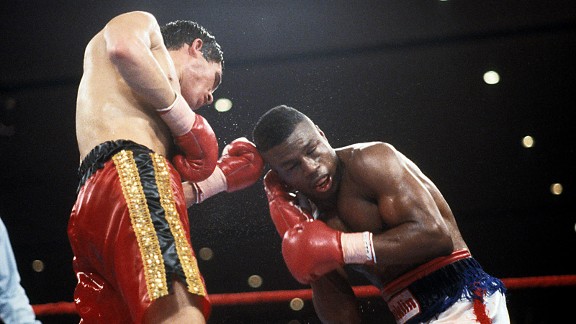 Photo by Ken Levine/All Sport/Getty Images
Photo by Ken Levine/All Sport/Getty Images
The action was both intense and pulse quickening. After six rounds, Merchant, Lampley and unofficial judge Harold Lederman all had Taylor winning every round, scoring it 60-54.
With the action now entering the second half of the fight, Merchant pointed out that this is when Chavez usually came on and turned up the intensity, “This is the part of the fight when Chavez usually starts to take over.”
Round 7 and 8 looked much like the first half of the fight. Taylor controlled the action and was landing punches in bunches. His combination punching was in sharp contrast to Chavez landing only one or two hammering punches at a time.
After the bell sounded to end the eighth round, the Chavez corner was desperate, pleading with him, “Do it for your family! Give it all your heart! For the love of God, throw everything you’ve got Julio!”
In the ninth, Taylor unloaded a sizzling flurry to begin the round. An animated Lampley shouted, “Look at the speed of Meldrick Taylor’s flurries! Reminiscent of a young Ray Leonard!”
The 10th round saw the two standing toe to toe as Chavez had kicked it into high gear. Taylor continued to out-throw and out-land Chavez, overwhelming him with his speed and the sheer volume of his punches.
Still taking three punches to land one, the power of Chavez was beginning to visibly take its toll on Taylor.
Blood continued to trickle from Taylor’s mouth and was now dripping from his nose. His face began to show signs of battle damage as massive swelling began around both eyes.
Lampley sensed a slight shift in the ebb and flow of the action, “Chavez finally seizing the initiative for the first time. And for the first time there is a mild air of danger for Meldrick Taylor.”
Round 11 was a near replica of the 10th with both standing and firing at close quarters. While the blood flowed and the swelling continued, Taylor continued to outwork Chavez.
Just before the bell sounded, Chavez landed a pair of solid right hands as Lampley summarized the action, “And Taylor was woozy and almost went to the wrong corner. He doesn’t have a lot left, Larry.”
While in between rounds, Lederman shared that he had Taylor ahead 9-2, scoring the action 108-101. Simultaneously, Duva and Benton were pleading with Taylor, “This is the last round! We need this round! The fight is hanging on this round Mel.”
Entering the 12th and final round, Lampley pointed out that if Taylor continued on his feet, he wins the fight. Leonard agreed, “Play it safe and box.”
Once polar opposites in their styles, both men now followed their corners advice and elected to trade at center ring. Taking turns pursuing one another, the action was blazing and passionate as they came down the stretch.
With 25 seconds remaining in the fight, Chavez landed a straight right hand that buckled Taylor’s knees. As he staggered back into a corner, Chavez pursued him and landed another straight right hand that put him on the seat of his pants.
Merchant proclaimed, “If he gets up, he probably wins the fight.”
Swollen and bloodied, Taylor pulled himself up at the count of five. Steele reached the count of eight and while in the face of Taylor asked, “Are you okay? Are you okay?”
Not verbally answering, Taylor did appear to give Steele a slight nod. Looking closely, Steele then shook his head while waving his arms above his head.
The crowd roared as the bout was stopped at 2:58 of the last round.
Lampley screamed, “Unbelievable! Unbelievable! Richard Steele stopped the fight with fewer than five seconds to go! You’re going to watch Lou Duva go crazy now! You’re going to see Lou Duva go absolutely berserk!”
Indeed, Duva charged into the ring and unloaded an all-out verbal tirade on Steele.
Fans stood and applauded both fighters for several minutes. The HBO team discussed the stoppage as possibly premature given there were only seconds remaining.
Lederman then weighed in, “Richard Steele made the right call without question. He didn’t respond to Steele’s question. It’s a shame it had to happen, but I agree with Steele 100 percent.”
Interviewed in the ring by Merchant, Steele commented, “I’m not the timekeeper and I don’t care about the time. I was looking at his condition. There’s no fight worth a man’s life.”
Astonishingly, prior to going off the air, Lampley shared that although Taylor would have won a decision on the judge’s scorecards, it would have been via a split decision as one of the three judges scored the bout for Chavez.
Ringside physician Dr. Flip Homansky examined Taylor immediately following the fight.
He instantly sent him to the hospital and described his injuries, “Meldrick suffered a facial fracture. He was urinating pure blood. His face was grotesquely swollen. This was a kid who was truly beaten up to the face, the body and the brain.”
Taylor spent the night in Valley Hospital where he received treatment for his injuries. He received a transfusion to replace the two pints of blood lost in the pitched battle with the rugged Chavez.
Although a strong case can be made that Steele should have been aware of the time and let the fight continue, an equally strong case can be made otherwise. It is important to note that Taylor’s corner instructed him that he needed the round and that the fight was close.
What would have happened if he had done as Leonard suggested at the beginning of the final round, to play it safe and box?
It is also critical to note that Taylor did not answer Steele, who asked him twice, if he was okay. It is the fighter’s responsibility to convince the referee that he is coherent and able to continue.
Ring Magazine would name this bout the “Fight of the Year” in 1990.
Nearly 10 years later, they would go on to name it the “Fight of the Decade.”



